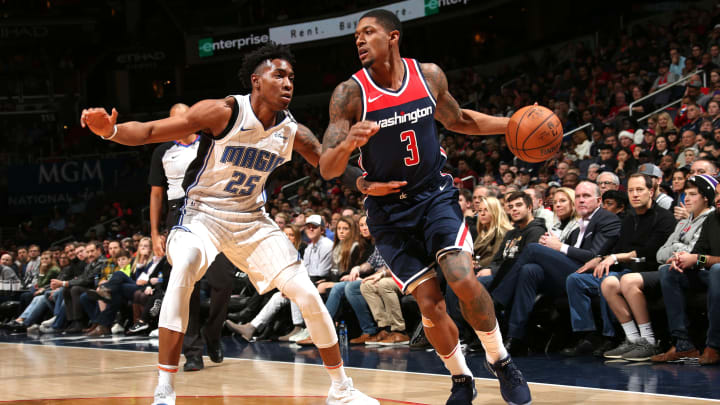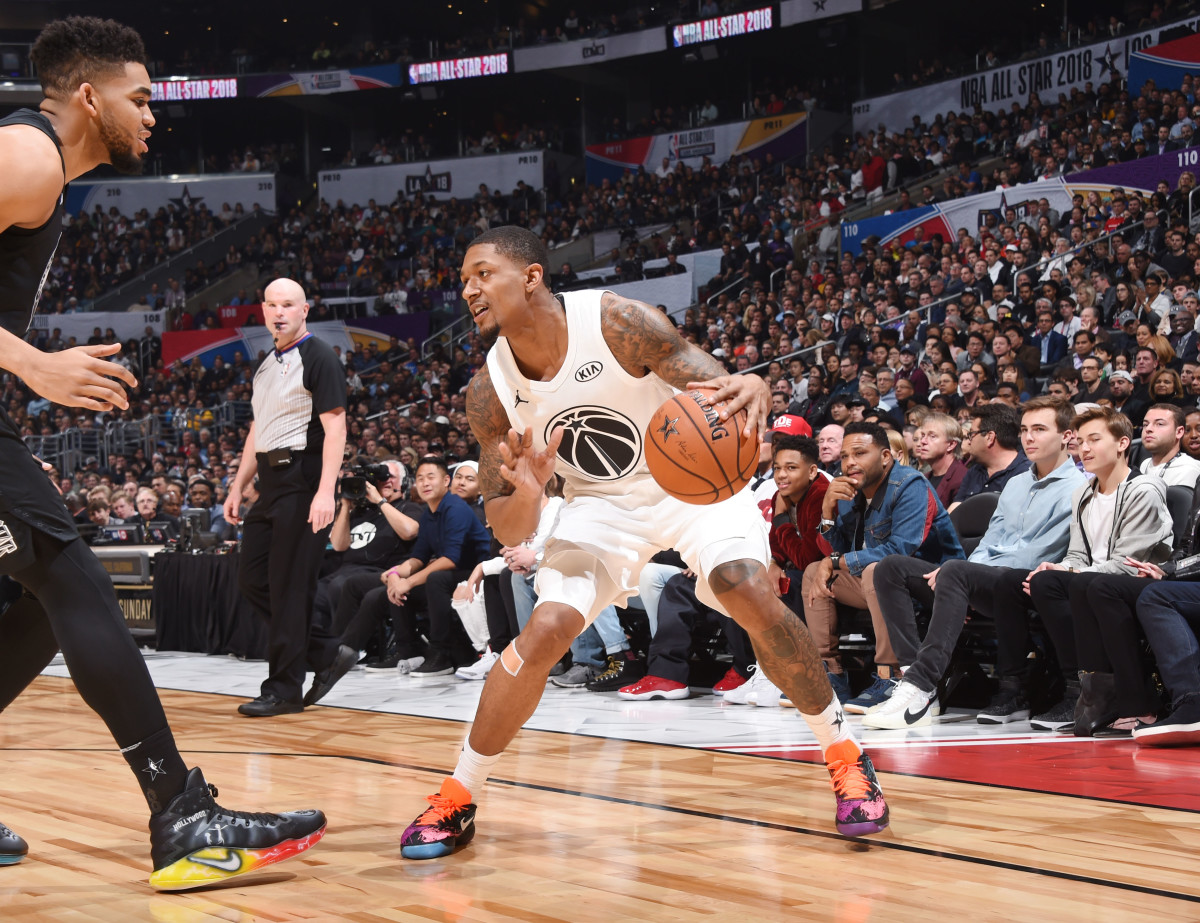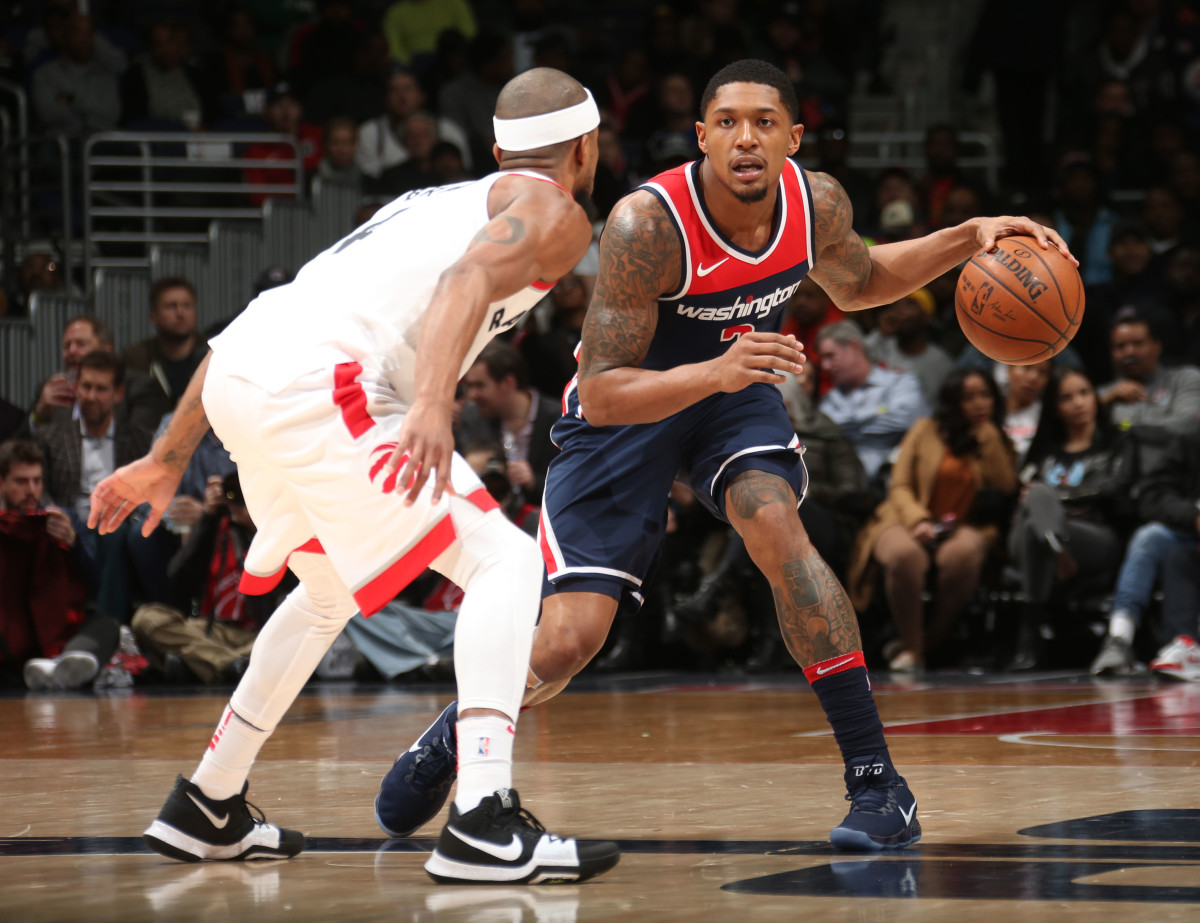My Signature Move: Bradley Beal Explains What Makes His Step-Back So Unstoppable

To celebrate Bradley Beal's first All-Star selection, The Crossover's Jared Zwerling recently joined him on the practice court in Washington D.C., to discuss his best season and break down his signature moves, featuring his trademark step-back jumper. With John Wall still out (knee surgery), Beal has led the Wizards to an 10–3 record, keeping them in position for home court in the East.
Here's an excerpt of their conversation:

Jared Zwerling: Huge year for you. You're a first-time All-Star. What's working out so well with your game?
Bradley Beal: Pretty much everything, man. I feel like my biggest thing is confidence, constantly growing. With confidence, you feel like you can pretty much do anything on the floor. And I just feel like offensively, it's being able to playmake a little bit more—not just being known as a shooter, but putting the ball on the floor, getting to the basket, creating for my teammates, and just being more dynamic and being more versatile in my game. And then taking it on the defensive end, too. So I feel like every aspect of it. I always tell myself, 'Nothing's perfect.' I always want to continue to get better, but I feel like my ball handling and my playmaking ability is probably what got me to the level I'm at now.
JZ: Are you noticing that you're seeing new angles on the court being more of a playmaker?
BB: Yes and no, because sometimes it's like, 'What took me so long being able to make that read?' And I feel like the older I get, the game just constantly slows down for me. And it's just constantly watching film and realizing how teams are going to play me, and realizing our system and just knowing where guys are going to be. I feel like it makes it a lot easier for me to make the right play, make the right read and just make the right play at the right time. So it's just constantly using all my resources at that, too—coaches, film, knowing where players like the ball, knowing my spots as well. So it's taking advantage of everything the defense gives me.
JZ: How do you analyze yourself watching film? What's your mental checklist when you break down your game?
BB: I like to see the good and the bad. You always want to see the good to be able to see, 'OK, well, this is what works, this is the success that I had doing this or whatever it may be.' But always seeing the bad because you want to improve, you want to get better at it as much as possible. I look at probably the bad more than anything and I feel like nobody critiques themselves more than I criticize myself. I really don't even know how to take a compliment honestly. So for me it's just that constant notion of wanting to get better and wanting to be the best I can possibly be.
JZ: For you, what do you look at as a 'bad' play?
BB: It could be a bad pass, a bad shot, the reason I missed a shot or a rotation on defense, whatever it may be. Because my game is never perfect; I make a mistake every game. So it's just a matter of getting into my head of knowing, OK, if I'm in that situation again, what to do, knowing what read to make next time. It's a learning experience, everything for sure.
Breakaway: How DeMar DeRozan Keeps Defenses Guessing
JZ: What do you consider the highlights of your season thus far?
BB: I think the 51-pointer probably takes the crown. It's probably the best game that I've played in from a zone standpoint, just being locked in and kind of just feeling like I was unstoppable. That's always a great feeling. There's plenty of guys around the league who've hit 50 and know the exact feeling. And getting the win. I think the win is probably the most important thing. If I had 50 in a loss, I wouldn't be talking about it. So for me, it's all about getting wins, man, and I think I'm most proud of our play with John being out. He's injured and he's such a valuable piece to our team. But I feel like guys are doing a great job of stepping up and filling in his shoes.
JZ: How much playmaking have you learned from John in film sessions and one-on-one chats?
BB: A lot because he has a huge IQ for the game and he sees plays develop probably before they're developing. That's always unique. This is my sixth year playing with him, so I've been witnessing this for a little while now. So I steal a lot of stuff from him because he's a terrific passer, a great pass-first guy and his ability to score just opens up everything for everybody else. So there's a lot of stuff—his pick-and-roll game and my transition game is nowhere near his, so I'm not even going to compare that. But he's so dynamic in a lot of ways, man, and I definitely watch him just as well as a lot of guards around the league, too.
JZ: With your best season yet, do you sense that defenses are playing you tighter now? Do you feel there are more traps and blitzes coming at you?
BB: It's every game. I'm so used to it by now, like I've got the whole game plan of what we need to do to defeat it now because I face it every game. So at first, I was probably turning it over at a high rate because I never really faced a double team probably since high school, so for me obviously this is a whole new level. So it took some getting used to and some adjustments to make on our end. And I feel like mentally it kind of challenged me to be able to see it as a sign of respect in a way and not get too frustrated with it—just make the right play and trust my teammates to do the same.
JZ: How would you characterize your signature moves? What are those for you?
BB: I feel like they're smooth. My favorite is my step-back. I feel like if I'm able to get to my step-back, there's pretty much nothing you can do because I'm confident in my jumper, my jump shot, and I feel like my momentum, my change of pace and change of direction is pretty solid when I go to it. So that's probably my No. 1 for sure. And my crossover jab, getting to the basket as much as possible. And my turnaround spin jumper, too.
JZ: How do you work on them behind the scenes?
BB: My trainer, Drew Hanlen. We've been working on them. It's crazy because we've been working on that since I was in high school and college, but I never used them in the game. And I used to always get frustrated and kind of irked with myself because I had so many moves in my arsenal. I just never put them into play until like the last couple years. And I finally gained the confidence and the freedom to be able to do so on the court, and it's kind of a natural thing now. If you want to be an elite person, you've got be able to show you can score in a variety of ways. So I just put a few go-to's in my arsenal and just use them to the best of my abilities.
JZ: Why is the step-back so popular in the game today?
BB: I feel like because honestly it's a tough shot and I feel like at the same time you create so much space. And it's kind of like a crossover without crossing over because you're creating space and your defender can still be going one way and you're going the other way. So in a way, it's kind of like a no-dribble crossover when you think about it. So for me, it's just an easier way for me to get into my jumper. It catches the defenders off guard. You're going downhill and your defender can still be going downhill, and you're going backwards into your jumper. So that's why.
JZ: I feel like what separates you with your step-back is your long stride. How much training goes into that movement for you?
BB: I naturally have a long stride anyways, so it's kind of very natural for me. I've been like this since I was a kid. That's kind of a good thing and a bad thing because I'm able to create a lot of space, but then it's like my long stride gets me in trouble sometimes because sometimes I go too far and can slip or over-exaggerate it a little bit too much. But for the most part, it works out well. From a training standpoint, I feel like I do my PT work and my hips, and making sure that my hips and stuff run into my shot, and making sure my ankles are strong. Because a lot of times, there's been times where I would twist my ankle trying to do the move. So it's not the easiest.
It's also difficult because I try to perfect it both ways—not just going left, but trying to do it going right because right is more for left-handers versus going left is for right-handers. So for me, I love going to it because it's a space-maker when you're able to create so much space going left. And I even try to do it going right. It's difficult for you to guard and it's been a go-to for me for years now, and I know a lot of defenders are starting to catch on to it, so I've got to start incorporating more stuff into it. Teams are starting to see it, too, whenever I catch the ball. They're, like, 'He's going left and shooting a step-back.' And about nine times out of 10, I'll do that. So I've got to incorporate something else into it.
NBA Power Rankings: The Wizards Are Rolling Without John Wall
JZ: How did you come up with the crossover jab-step move?
BB: My biggest thing for all my moves is just the ability to create space to get to my shot because I feel like if I can get to my shot, it's going to go in. So the simple jab, that's just an automatic, like as soon as I catch the ball, I'm jabbing one way, going the other. I'm jabbing one way and double crossing back to the same hand, like it's a lot of stuff that I incorporate into it. My mind kind of just goes all over the place when I think about it. But in a way, it's quite simple. Whatever move I feel like I can create space off of is going to be my go-to.
JZ: The pound pivot is different for you because it's more in or near the paint off of a deep drive, versus your step-backs from further out.
BB: For sure. I do it a lot when I have bigs on me because bigs, they're trained to run you off the three-point line and then try to block your shot at the rim. And they want you to shoot like a long two, which is in their favor, or just bomb up a three. So for me, I feel like if I can get you downhill and get your momentum going one way, I'm pretty good at stopping on a dime either with my step-back, either with a pull-up or with a side-step or with my pound pivot. So I've got a few things, a few tricks that I use on people to get my shot off.
JZ: How often do you surprise yourself with a move, where you run back on defense, like, 'What did I just do?'
BB: I feel like it doesn't hit me as much. I feel like I should be doing that stuff now at this point in my career. And I feel like maybe at the beginning of last year maybe, even the end of the year before that, I feel like that's when I really started to blossom into putting the ball on the floor and going into the package a little bit more. So this year, I'm not really too surprised by a lot of stuff. There are some moves that I'm like, 'Damn, I really hit him with something right there' or 'I really put a good move on him.' But a lot of times, it doesn't surprise me no more.

JZ: Which greats have you watched through the years to see how they create space?
BB: Kobe's footwork I'm a huge fan of because he prides himself on that and I feel like that's an important piece to the game—having the proper footwork and the strength, and just knowing where you are on the floor by just looking at the floor. And I feel like he's somebody who's big on just getting to his spots and knocking down his jumper. So I take that out of his book and I feel like James Harden has one of the best step-backs in the game, too. So I definitely watch a lot of his clips, him, D-Wade and a few AI [Allen Iverson] clips as well. So I just try to incorporate all that into one, into my own comfort level.
JZ: Do you have tricks to absorb contact like James does to draw a foul? Do you look for that bump?
BB: You know what? I'm not good at it. I feel like jumping in the air and creating that contact, I'm really good at finishing that way. But in terms of like getting into somebody's body and sweeping through like James does or like a lot of the guys do, I'm like terrible at it. I don't know why. I feel like I can't do it, and it's like something I'm not comfortable with, so I just scratch it out of my game.
JZ: Another move you're good at is the hesitation in transition. You'll come down and fake you're going to shoot a three, and then blow by your defender.
BB: For sure. For me, I try to keep it simple. For me, the hesitation is perfect for me. I feel like it's an easy move to do. A lot of people know I love to shoot threes and I'm capable of shooting threes, whether off the dribble, in transition or whatever it may be. So it's momentum, and I feel like change of pace, change of speed, change of direction and space are all key components to me. So if I feel like if you're going to even flinch in a jump, I'm going to go by you. So that's definitely another go-to.
JZ: You mentioned the step-back going right as a work in progress. Any other moves you're trying to master?
BB: Pull-backs whether between the legs or a straight pull-back. Behind-the-back pull-back. Hesitation going right. It's pretty much the same thing on the right. I try to equal it on both sides.
The Great Tank-Off: Who Will Win the NBA's Race to the Bottom?
JZ: With the court stretched out further and players shooting longer threes, are you also practicing more step-backs from deeper range?
BB: Most definitely. You've got to take it in baby steps. I started in the midrange, in the paint and then there are times where I step out to the three. So as much as possible, I try to work on it, craft it. I feel like that's the next step for me—being able to shoot consistently off the dribble from three. So it's still a work in progress, but so far so good.
JZ: So what's the next phase of Bradley Beal looking ahead?
BB: Just keep getting better. I think the main concern is just keep winning. I'm not necessarily worried about my individual stuff right now. I'm happy to be an All-Star; I'm not satisfied with it. I definitely want to get better and continue to get better, but I feel like stats-wise and all the other stuff, I could really care less about. I just want to win and do whatever it takes to be able to hold that trophy up at the end of the year.
